Unit 3 Celebrations Writing Workshop课件(共31张)北师大版(2019)必修第一册(共32页)
文档属性
| 名称 | Unit 3 Celebrations Writing Workshop课件(共31张)北师大版(2019)必修第一册(共32页) | 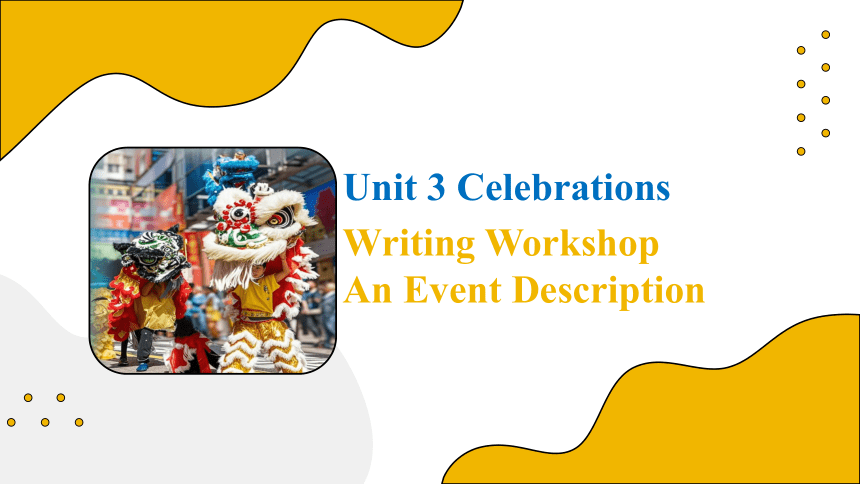 | |
| 格式 | pptx | ||
| 文件大小 | 57.0MB | ||
| 资源类型 | 教案 | ||
| 版本资源 | 北师大版(2019) | ||
| 科目 | 英语 | ||
| 更新时间 | 2025-08-01 11:02:49 | ||
图片预览

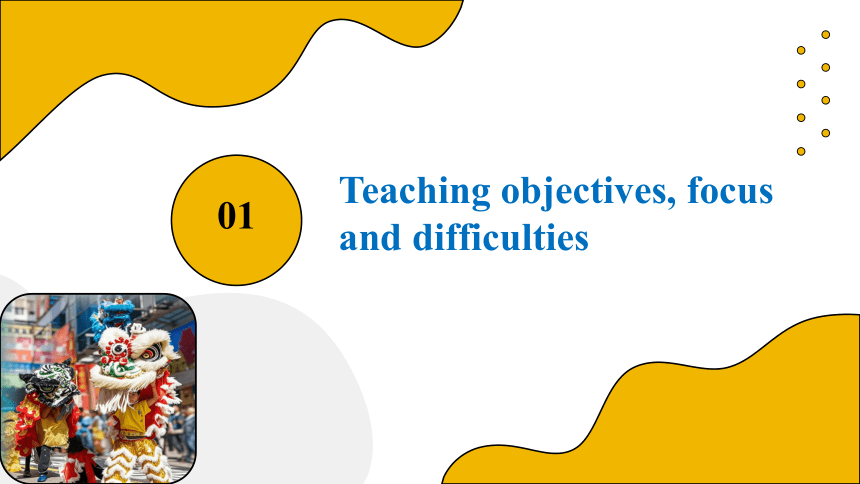
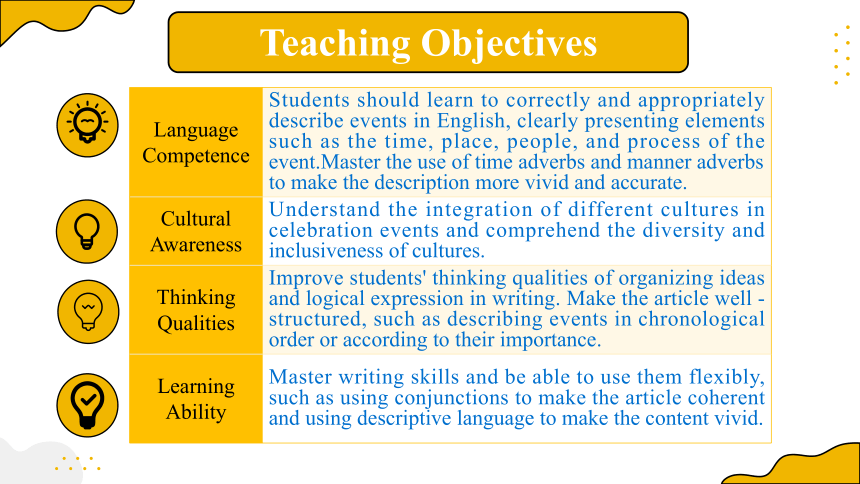
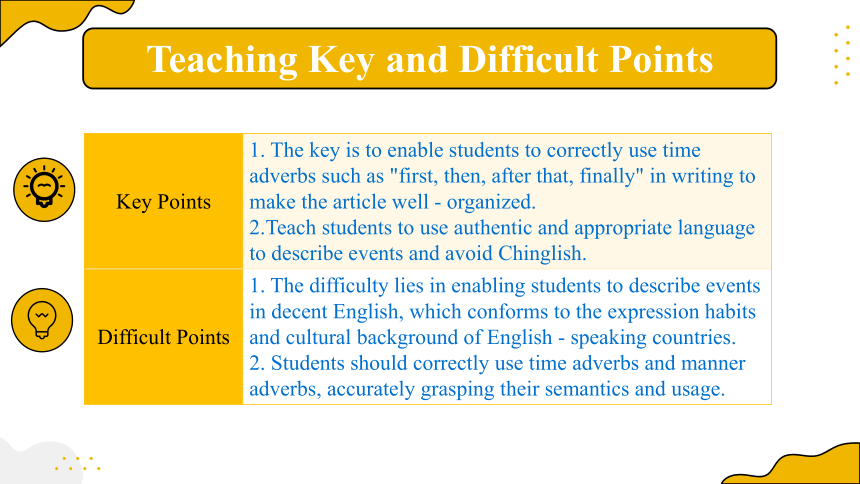
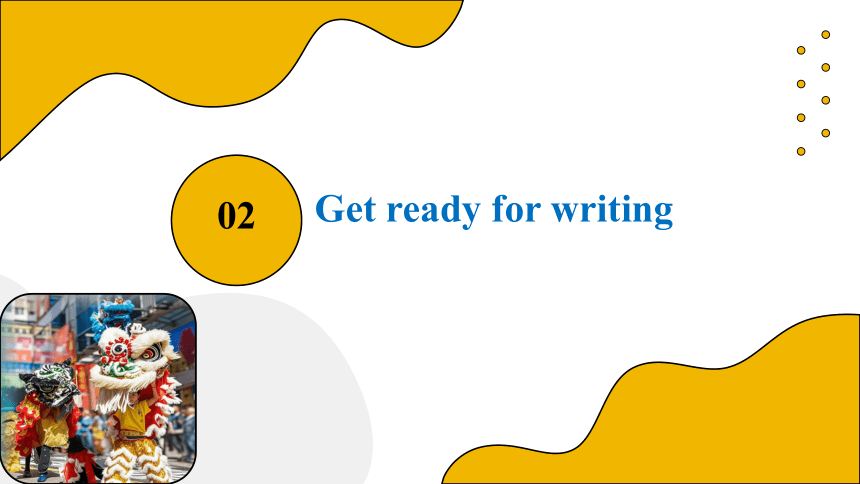
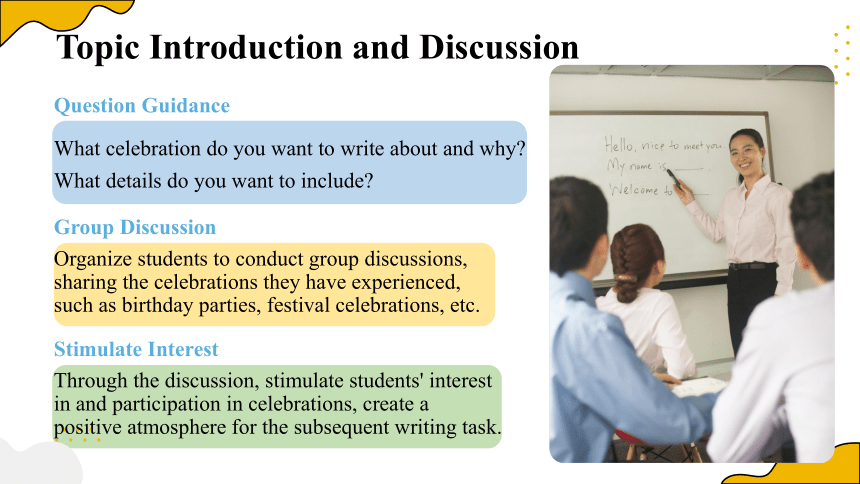
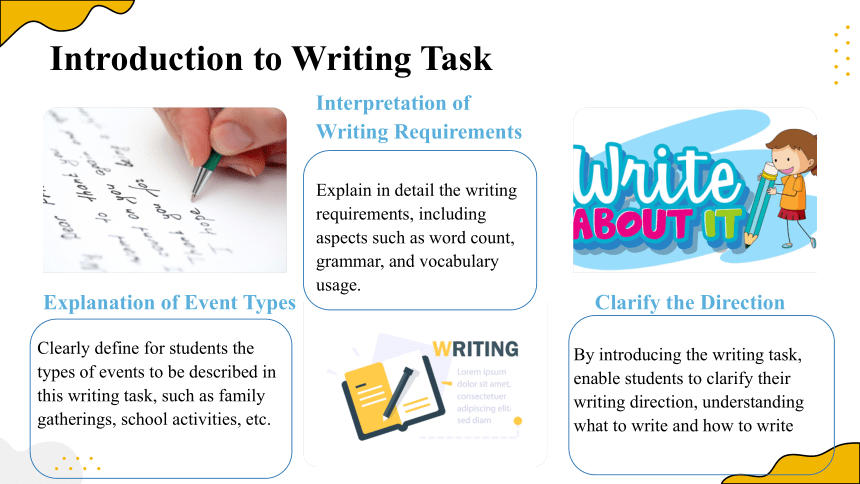
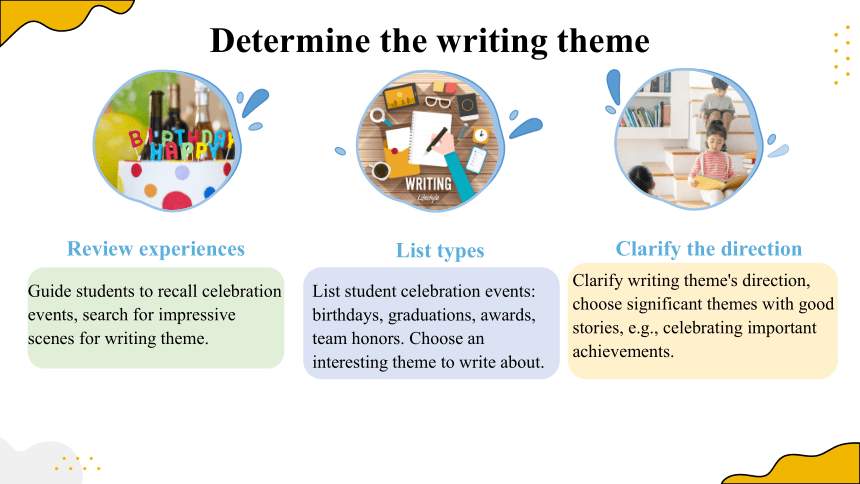
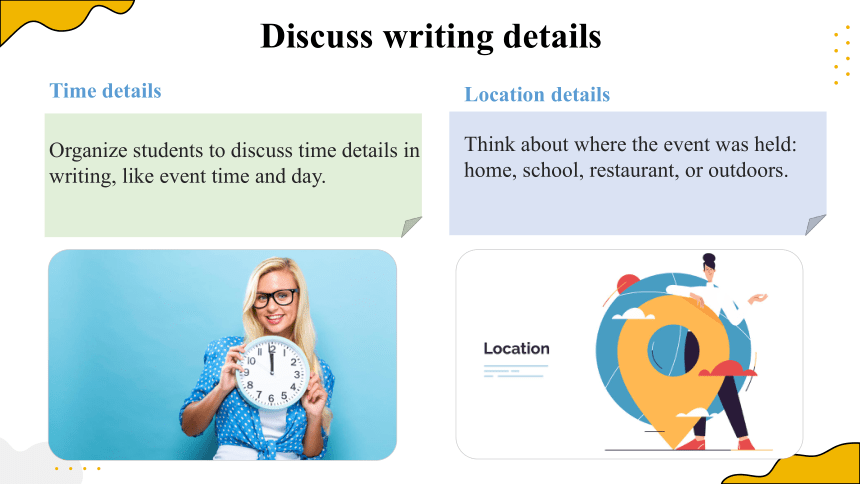
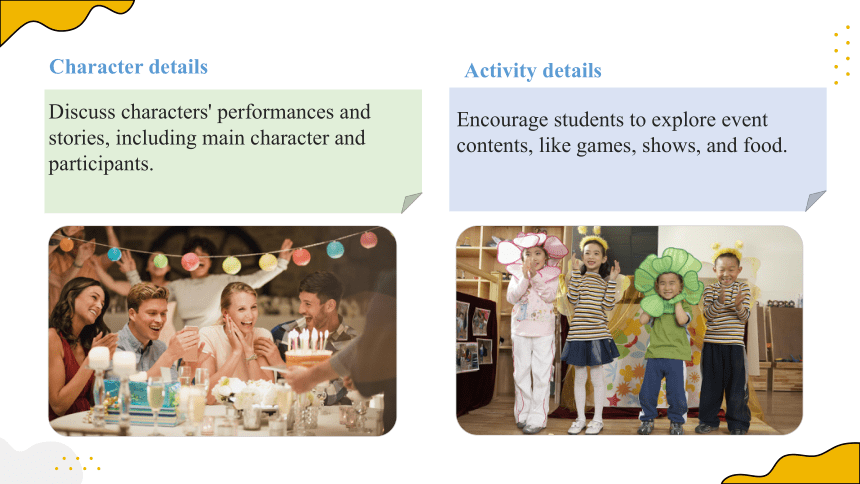

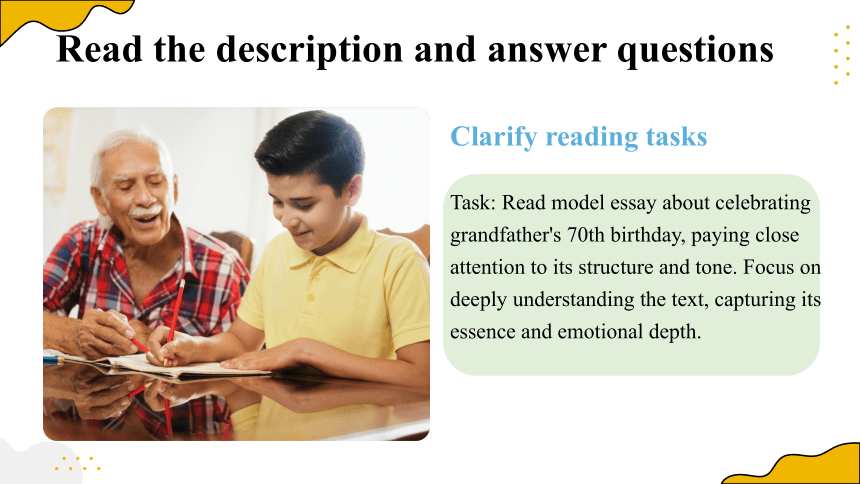
文档简介
(共31张PPT)
Unit 3 Celebrations
Writing Workshop
An Event Description
Teaching objectives, focus and difficulties
01
Teaching Objectives
Language Competence Students should learn to correctly and appropriately describe events in English, clearly presenting elements such as the time, place, people, and process of the event.Master the use of time adverbs and manner adverbs to make the description more vivid and accurate.
Cultural Awareness Understand the integration of different cultures in celebration events and comprehend the diversity and inclusiveness of cultures.
Thinking Qualities Improve students' thinking qualities of organizing ideas and logical expression in writing. Make the article well - structured, such as describing events in chronological order or according to their importance.
Learning Ability Master writing skills and be able to use them flexibly, such as using conjunctions to make the article coherent and using descriptive language to make the content vivid.
Key Points 1. The key is to enable students to correctly use time adverbs such as "first, then, after that, finally" in writing to make the article well - organized.
2.Teach students to use authentic and appropriate language to describe events and avoid Chinglish.
Difficult Points 1. The difficulty lies in enabling students to describe events in decent English, which conforms to the expression habits and cultural background of English - speaking countries.
2. Students should correctly use time adverbs and manner adverbs, accurately grasping their semantics and usage.
Teaching Key and Difficult Points
Get ready for writing
02
Topic Introduction and Discussion
Question Guidance
What celebration do you want to write about and why
What details do you want to include
Group Discussion
Organize students to conduct group discussions, sharing the celebrations they have experienced, such as birthday parties, festival celebrations, etc.
Stimulate Interest
Through the discussion, stimulate students' interest in and participation in celebrations, create a positive atmosphere for the subsequent writing task.
Introduction to Writing Task
Explanation of Event Types
Clearly define for students the types of events to be described in this writing task, such as family gatherings, school activities, etc.
Interpretation of Writing Requirements
Explain in detail the writing requirements, including aspects such as word count, grammar, and vocabulary usage.
Clarify the Direction
By introducing the writing task, enable students to clarify their writing direction, understanding what to write and how to write
Guide students to recall celebration events, search for impressive scenes for writing theme.
Review experiences
List types
Clarify the direction
Determine the writing theme
List student celebration events: birthdays, graduations, awards, team honors. Choose an interesting theme to write about.
Clarify writing theme's direction, choose significant themes with good stories, e.g., celebrating important achievements.
Discuss writing details
Organize students to discuss time details in writing, like event time and day.
Time details
Think about where the event was held: home, school, restaurant, or outdoors.
Location details
Discuss characters' performances and stories, including main character and participants.
Character details
Encourage students to explore event contents, like games, shows, and food.
Activity details
Read for writing
03
Read the description and answer questions
Clarify reading tasks
Task: Read model essay about celebrating grandfather's 70th birthday, paying close attention to its structure and tone. Focus on deeply understanding the text, capturing its essence and emotional depth.
Answer key questions
Students answer key questions to sort out the plot, grasp essential information, and deepen their understanding of the text content.
Read the description and answer questions
Read the description and answer questions
Conduct group discussions
Students discuss answers in groups, sharing ideas. Discussion deepens understanding of the essay.
Summarize key information from the description.
Extract event-related details
Guide students to extract core event: grandfather's 70th birthday. Clarify event to grasp theme.
Summarize key information from the description.
Organize preparatory content
Students sort preparations for birthday, like cooking special food and inviting friends. Understanding preparations helps appreciate efforts and planning.
Summarize key information from the description.
Synthesize feelings and comments
Students summarize grandfather's excitement and comments, understanding the celebration's significance.
Read the description. Answer the questions.
It was Grandpa's birthday.
Whose birthday was it
1
2
The writer made a video of Grandpa's life story for him.
What gift did the writer make
3
4
Mum cooked special food. They invited Grandpa's friends.
What did the family do to prepare for it
The event made Grandpa very excited. He said it was a "wonderful birthday celebration" and that he was "looking forward to his eightieth, ninetieth and even one hundredth birthdays already!"
How did Grandpa feel and what did he say
Focus on structure and language
04
Analyze the structure of the text
Introduction to the event
The best part of the event
01
02
03
04
Preparations before the event
Feelings about the event
Introduction to the event
Preparations before the event
The best part of the event
Feelings about the event
Grandpa's 70th birthday
birthday lunch; gift (video)
invitation to Grandpa's old friends;
when Grandpa and his friends appeared in an old photo in their school uniforms
excited
Introduction to the event
Model essay's intro states event, time, reason, participants. Example: Grandpa's 70th bday clearly points out it's his birthday.
Preparations before the event
This part explains preparations. Mum cooked food and invited friends. These laid foundations for the celebration.
The best part of the event
Model essay describes memorable part of celebration. Example: Grandpa and friends in old school uniform photo brought climax.
Feelings about the event
This part expresses the participants' feelings and evaluations of the entire celebration. Grandpa said it was a wonderful birthday celebration, which reflects the positive impact of the event.
Read the text again. Underline the words used to link sentences and paragraphs. Then, write 2-3 similar sentences for your writing. Use the Sentence Builder to help you.
Adverbs of Time and Manner
first / then / after that / finally
First I got dressed. Then I headed downstairs.
luckily / amazingly / surprisingly / excitedly
Surprisingly, they were Grandpa's best friends from secondary school.
Sentence Builder
Guide students to find out the words used to connect sentences and paragraphs in the model essay, such as time adverbs like "first", "then", "after that", "finally", and manner adverbs like "surprisingly", "luckily". These words make the article more logical.
Vocabulary for connecting sentences and paragraphs
Let students pay attention to the adjectives and adverbs used in the model essay, such as adjectives like "awesome", "quick", "special", and adverbs like "quickly", "surprisingly". They can make the description more vivid.
Adjectives and adverbs that make descriptions vivid
Learning connectives and descriptive language
Let students pay attention to the adjectives and adverbs used in the model essay, such as adjectives like "awesome", "quick", "special", and adverbs like "quickly", "surprisingly". They can make the description more vivid.
Descriptions of characters' physical and mental states
Learn the descriptions of people's physical and psychological states in the model essay, such as "couldn't believe his eyes", "it took quite a long time for them to calm down". These descriptions can enhance the appeal of the article.
Evaluative statements
Compose your writing
05
Complete the outline of your event description based on Activity 3.
1. Outlining
Use the outline and the Writing Help to write your first draft.
2. Drafting
Edit your description in pairs. Then share what you have written in class.
3. Editing
Help students set writing framework based on event description, including intro, preparations, memorable parts, and feelings, for complete and organized content.
Clarify the writing framework
Sort out key points
Arrange the order reasonably
List the writing outline
Guide students to sort out key info for writing, like time, place, characters, content, and features, for a targeted outline.
Arrange content order, use linking words (first, then, after that, finally) for clarity.
Complete the first draft and share it
Write according to the outline
Students draft event description per outline, using learned language, ensuring accuracy and fluency.
Share within the class
Organize students to share drafts to learn from each other and broaden horizons.
Evaluate and learn from each other
Guide students to evaluate shared works and give opinions/suggestions on content, language, logic for progress.
Summary
06
1. The writing structure of event description, including event introduction, pre - event preparations, the most memorable part, and feelings about the event.
2. Linking words can make the article more coherent.
3. Descriptive language makes the article vivid and detailed.
Homework
07
Ask students to choose a new celebration event to describe, such as a school sports meeting or a class party. Use the writing structure and language expressions learned in class to describe the preparations, process and feelings of the event in detail.
Unit 3 Celebrations
Writing Workshop
An Event Description
Teaching objectives, focus and difficulties
01
Teaching Objectives
Language Competence Students should learn to correctly and appropriately describe events in English, clearly presenting elements such as the time, place, people, and process of the event.Master the use of time adverbs and manner adverbs to make the description more vivid and accurate.
Cultural Awareness Understand the integration of different cultures in celebration events and comprehend the diversity and inclusiveness of cultures.
Thinking Qualities Improve students' thinking qualities of organizing ideas and logical expression in writing. Make the article well - structured, such as describing events in chronological order or according to their importance.
Learning Ability Master writing skills and be able to use them flexibly, such as using conjunctions to make the article coherent and using descriptive language to make the content vivid.
Key Points 1. The key is to enable students to correctly use time adverbs such as "first, then, after that, finally" in writing to make the article well - organized.
2.Teach students to use authentic and appropriate language to describe events and avoid Chinglish.
Difficult Points 1. The difficulty lies in enabling students to describe events in decent English, which conforms to the expression habits and cultural background of English - speaking countries.
2. Students should correctly use time adverbs and manner adverbs, accurately grasping their semantics and usage.
Teaching Key and Difficult Points
Get ready for writing
02
Topic Introduction and Discussion
Question Guidance
What celebration do you want to write about and why
What details do you want to include
Group Discussion
Organize students to conduct group discussions, sharing the celebrations they have experienced, such as birthday parties, festival celebrations, etc.
Stimulate Interest
Through the discussion, stimulate students' interest in and participation in celebrations, create a positive atmosphere for the subsequent writing task.
Introduction to Writing Task
Explanation of Event Types
Clearly define for students the types of events to be described in this writing task, such as family gatherings, school activities, etc.
Interpretation of Writing Requirements
Explain in detail the writing requirements, including aspects such as word count, grammar, and vocabulary usage.
Clarify the Direction
By introducing the writing task, enable students to clarify their writing direction, understanding what to write and how to write
Guide students to recall celebration events, search for impressive scenes for writing theme.
Review experiences
List types
Clarify the direction
Determine the writing theme
List student celebration events: birthdays, graduations, awards, team honors. Choose an interesting theme to write about.
Clarify writing theme's direction, choose significant themes with good stories, e.g., celebrating important achievements.
Discuss writing details
Organize students to discuss time details in writing, like event time and day.
Time details
Think about where the event was held: home, school, restaurant, or outdoors.
Location details
Discuss characters' performances and stories, including main character and participants.
Character details
Encourage students to explore event contents, like games, shows, and food.
Activity details
Read for writing
03
Read the description and answer questions
Clarify reading tasks
Task: Read model essay about celebrating grandfather's 70th birthday, paying close attention to its structure and tone. Focus on deeply understanding the text, capturing its essence and emotional depth.
Answer key questions
Students answer key questions to sort out the plot, grasp essential information, and deepen their understanding of the text content.
Read the description and answer questions
Read the description and answer questions
Conduct group discussions
Students discuss answers in groups, sharing ideas. Discussion deepens understanding of the essay.
Summarize key information from the description.
Extract event-related details
Guide students to extract core event: grandfather's 70th birthday. Clarify event to grasp theme.
Summarize key information from the description.
Organize preparatory content
Students sort preparations for birthday, like cooking special food and inviting friends. Understanding preparations helps appreciate efforts and planning.
Summarize key information from the description.
Synthesize feelings and comments
Students summarize grandfather's excitement and comments, understanding the celebration's significance.
Read the description. Answer the questions.
It was Grandpa's birthday.
Whose birthday was it
1
2
The writer made a video of Grandpa's life story for him.
What gift did the writer make
3
4
Mum cooked special food. They invited Grandpa's friends.
What did the family do to prepare for it
The event made Grandpa very excited. He said it was a "wonderful birthday celebration" and that he was "looking forward to his eightieth, ninetieth and even one hundredth birthdays already!"
How did Grandpa feel and what did he say
Focus on structure and language
04
Analyze the structure of the text
Introduction to the event
The best part of the event
01
02
03
04
Preparations before the event
Feelings about the event
Introduction to the event
Preparations before the event
The best part of the event
Feelings about the event
Grandpa's 70th birthday
birthday lunch; gift (video)
invitation to Grandpa's old friends;
when Grandpa and his friends appeared in an old photo in their school uniforms
excited
Introduction to the event
Model essay's intro states event, time, reason, participants. Example: Grandpa's 70th bday clearly points out it's his birthday.
Preparations before the event
This part explains preparations. Mum cooked food and invited friends. These laid foundations for the celebration.
The best part of the event
Model essay describes memorable part of celebration. Example: Grandpa and friends in old school uniform photo brought climax.
Feelings about the event
This part expresses the participants' feelings and evaluations of the entire celebration. Grandpa said it was a wonderful birthday celebration, which reflects the positive impact of the event.
Read the text again. Underline the words used to link sentences and paragraphs. Then, write 2-3 similar sentences for your writing. Use the Sentence Builder to help you.
Adverbs of Time and Manner
first / then / after that / finally
First I got dressed. Then I headed downstairs.
luckily / amazingly / surprisingly / excitedly
Surprisingly, they were Grandpa's best friends from secondary school.
Sentence Builder
Guide students to find out the words used to connect sentences and paragraphs in the model essay, such as time adverbs like "first", "then", "after that", "finally", and manner adverbs like "surprisingly", "luckily". These words make the article more logical.
Vocabulary for connecting sentences and paragraphs
Let students pay attention to the adjectives and adverbs used in the model essay, such as adjectives like "awesome", "quick", "special", and adverbs like "quickly", "surprisingly". They can make the description more vivid.
Adjectives and adverbs that make descriptions vivid
Learning connectives and descriptive language
Let students pay attention to the adjectives and adverbs used in the model essay, such as adjectives like "awesome", "quick", "special", and adverbs like "quickly", "surprisingly". They can make the description more vivid.
Descriptions of characters' physical and mental states
Learn the descriptions of people's physical and psychological states in the model essay, such as "couldn't believe his eyes", "it took quite a long time for them to calm down". These descriptions can enhance the appeal of the article.
Evaluative statements
Compose your writing
05
Complete the outline of your event description based on Activity 3.
1. Outlining
Use the outline and the Writing Help to write your first draft.
2. Drafting
Edit your description in pairs. Then share what you have written in class.
3. Editing
Help students set writing framework based on event description, including intro, preparations, memorable parts, and feelings, for complete and organized content.
Clarify the writing framework
Sort out key points
Arrange the order reasonably
List the writing outline
Guide students to sort out key info for writing, like time, place, characters, content, and features, for a targeted outline.
Arrange content order, use linking words (first, then, after that, finally) for clarity.
Complete the first draft and share it
Write according to the outline
Students draft event description per outline, using learned language, ensuring accuracy and fluency.
Share within the class
Organize students to share drafts to learn from each other and broaden horizons.
Evaluate and learn from each other
Guide students to evaluate shared works and give opinions/suggestions on content, language, logic for progress.
Summary
06
1. The writing structure of event description, including event introduction, pre - event preparations, the most memorable part, and feelings about the event.
2. Linking words can make the article more coherent.
3. Descriptive language makes the article vivid and detailed.
Homework
07
Ask students to choose a new celebration event to describe, such as a school sports meeting or a class party. Use the writing structure and language expressions learned in class to describe the preparations, process and feelings of the event in detail.
同课章节目录
- Unit 1 Life Choices
- Lesson 1 Lifestyles
- Lesson 2 Understanding and Coping with Stress
- Lesson 3 Your Life Is What You Make It
- Unit 2 Sports and Fitness
- Lesson 1 The Underdog
- Lesson 2 Rules of the Game
- Lesson 3 Running and Fitness
- Unit 3 Celebrations
- Lesson 1 Spring Festival
- Lesson 2 Special Occasions
- Lesson 3 Memories of Christmas
